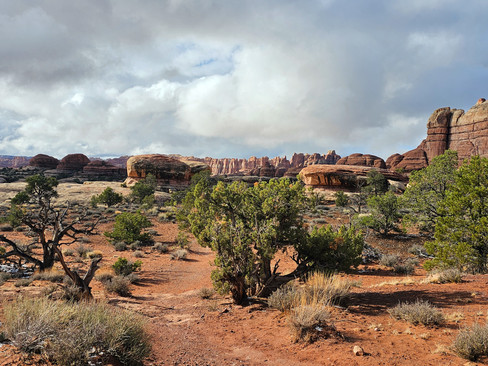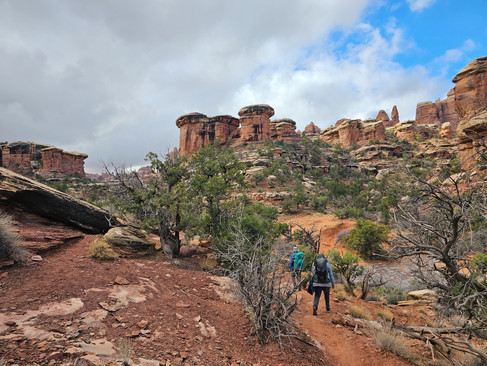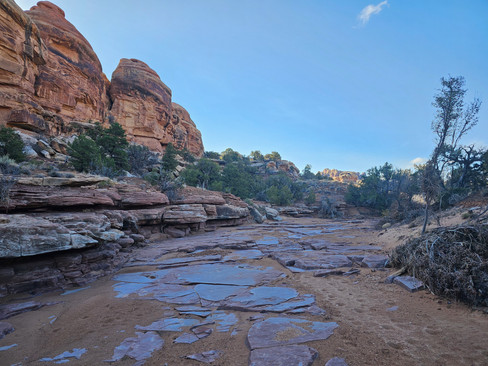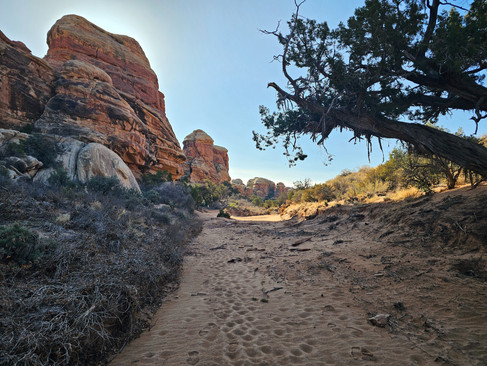Backpacking the Needles: A Passage Through Time
- Dan Wagner
- 3 days ago
- 13 min read
Updated: 3 days ago
The Needles District of Canyonlands National Park is a land of raw, untamed beauty—a labyrinth of towering sandstone spires, deep canyons, and windswept mesas that hold the echoes of an ancient past. Here, beneath the desert sun, time itself seems to erode like the red rock, revealing stories carved into stone and whispers of civilizations long vanished.
For those who dare to venture deep into this rugged wilderness, the rewards are breathtaking. In the shadowy alcoves of Devil's Lane, mysterious pictographs whisper of lost myths and the lives of those who walked this land long before us. The Cave of 200 Hands is a haunting testament to generations who left their mark in ghostly red imprints, a silent gathering of ancestral spirits pressed against the rock. Beyond it, The Joint awaits—an eerie, narrow fracture in the rock where light barely reaches, a passage through stone that feels like stepping into another world. And then there is Druid Arch, a towering sandstone gateway that rises like an ancient monolith, a sentinel standing watch over this sacred land.
At the heart of this wild expanse lies Chesler Park, a surreal meadow encircled by massive sandstone formations, where solitude reigns and the only sounds are the whispering wind and the crunch of boots on red earth. To backpack through this remote and storied terrain is more than a journey—it is a passage through time, where the land itself tells a story older than memory.


Trailhead elevation 5,122'
Water varies on season
Don't miss the Cave of 200 Hands, Chesler Park backcountry campsites
Backpacking the Needles
We reach the Elephant Hill Trailhead just after 8:00 AM on a crisp April morning, the desert air sharp and fresh with the promise of adventure. The rising sun casts long shadows across the sandstone, its warmth creeping across our backs as we prepare for the journey ahead.
With the weight of the wilderness before us, we overfill our water bottles, knowing that for the next two days, the parched earth may very well offer nothing. Packs are tightened, checked, and checked again—each strap and buckle a lifeline in this vast, unforgiving terrain. With permits tucked away and the thrill of the unknown crackling in the air, we take one last look at the world behind us. Then, with boots pressing into the earth, we cross the threshold into the untamed.
The trail lunges upward from the trailhead, immediately demanding our attention with a steep ascent over a jagged slickrock ramp that gleams in the sun like ancient armor. Soon, a narrow, shadowed joint swallows us, where we ascend a staircase into the very bones of the earth.

Then, suddenly, the land explodes open. We emerge onto a vast slickrock plateau that stretches to the horizon, where monolithic fins rise like the spines of some slumbering giant. Towering pinnacles, etched from Cedar Mesa Sandstone, stab into the sky, and peculiar mushroom-shaped boulders perch precariously on narrow stalks of stone. The colors—deep rust, sun-bleached tan, and soft gold—shimmer under the desert light. It’s surreal, like stepping onto another planet sculpted by fire and forgotten gods. We’re stunned into silence… then scrambling for our cameras. Every direction is a postcard. Every moment feels mythic.

We press on, breathless—not from the exertion, but from the sheer majesty of the land unraveling before us. With every step, our jaws hang slack, as if trying to drink in the impossible scale of it all. The trail dances through a wild rhythm—plunging into bouldered ravines thick with the twisted limbs of juniper, the spiny shadows of blackbrush, and the quiet strength of pinyon pines, each one clinging to life in cracks of sunburnt stone.

Then, just as suddenly, we rise—cresting a ridge where the world erupts into open sky. Before us, an ocean of red rock and endless canyonland stretches to the horizon and beyond, glowing under the vast blue dome overhead. It feels like standing on the edge of forever. I can’t help it—a grin breaks across my face, wide and unstoppable. The landscape doesn’t just reveal itself—it performs, peeling back layer after layer of ancient beauty with every mile.

As the landscape unfurls with theatrical flair, we slip into a narrow joint—a shadowed corridor carved by time itself—that pulls us deeper into this dreamlike odyssey. It’s as if the earth has cracked open to reveal a hidden passageway into another realm.

Our pace dwindles to a reverent crawl. The land demands it. Every curve in the trail offers another jaw-dropping panorama, another impossible sculpture of stone that begs to be admired. We stop every few steps, cameras raised like offerings, trying in vain to capture the scale, the silence, the soul of this stone-born fantasyland.

We climb through a break in a colossal wall of towering brown and orange sandstone needles—monuments rising like ancient sentinels along a two-mile spine of stone. At the top, we pause to look back over the surreal landscape we've traversed—a chaotic sea of fins, spires, and shadowed corridors that now seem like the scattered ruins of some forgotten world.

Then, the trail drops, and we descend into Chesler Park—a vast, hidden meadow once grazed by cattle, now reclaimed by the quiet resilience of the desert. The shift is striking. Where stone once dominated, now soft grasses sway in the breeze, mingling with sagebrush, cactus blossoms, and sun-dappled wildflowers. It's a sudden softness in an otherwise rugged land. We weave our way along the eastern edge of the park, the spires still looming in our periphery like watchful giants. With each quiet step, we draw closer to CP5, our home for the night, tucked beneath the shadows of these ancient red rock walls.

Just before we reach our camp—nestled in the stretch between CP4 and CP5—we stumble upon the remains of a forgotten cowboy camp, tucked beneath a wind-swept overhang like a secret whispered by the land itself.

Once, rough-handed cowboys called this place home, corralling cattle across this wild, sun-blasted basin. Though they vanished nearly a century ago, their presence lingers. Rusting tools, weather-worn cans, and a large wood burning stove lie scattered among the rocks, as if the desert simply froze their world mid-motion.

The camp was abandoned in the 1940s, yet it feels as though the men just stepped away—boots still echoing faintly in the dust. It’s a sacred little pocket of history, left behind for the rare wanderer lucky enough to find it. Written onto the sandstone, historical graffiti clings to the camp’s weathered walls. Among the faded scrawls, one message stands out—bold in its simplicity: “Dead or alive…”

At last, we reach camp and shed our packs, letting the weight of the day fall away. We set up our tents beneath a grouping of needles and fragrant junipers, but rest is fleeting—there’s an adventure still to be had. We gather ourselves and head toward Druid Arch, a towering monolith of stone rising 150 feet into the air at the head of Elephant Canyon

The hike takes us across the eastern edge of Chesler Park, where the grassy expanse gives way to slickrock slopes that descend sharply beneath our feet. The land smooths out as we reach a vast slickrock flat, where shallow potholes, worn into the stone over millennia, hold precious pools of water.

We push forward, descending once again into the abyss, our boots skidding down steep slickrock slopes that seem to drop straight into the heart of the canyon. The land is cloaked in a lush desert tapestry, where vibrant desert flora clings to life in the cracks and crevices of the stone, their colors a sharp contrast to the barren grandeur of the rock.

As we reach the sandy bottom of Elephant Canyon, it’s like stepping into a living dream. The canyon wraps around us, its towering walls rising high above, creating a cathedral of stone that feels both ancient and alive. This is one of Canyonlands' most stunning treasures—an awe-inspiring sanctuary, where every step feels sacred.

We move deeper into the canyon, and the views unfold around us, each one more breathtaking than the last. Every direction is a feast for the eyes, a landscape carved by time and painted by the hand of the universe itself. My camera is never far from my hand—either it’s capturing the magic or poised and ready, always prepared for the next jaw-dropping moment.

With Druid Arch finally in sight, we tackle the final stretch—a bolted ladder that leads us upward, each step bringing us closer. We scramble up a steep rockfall, moving carefully as loose stones shift beneath our feet. At the top, we find ourselves on a large, flat area, and there it is—Druid Arch, standing before us in all its glory. Rising nearly 500 feet from the canyon floor, the arch seems to float in the sky, its two keyholes cutting through the heavens like ancient celestial gateways. We sit in awe.

Not only is the arch—a namesake tribute to the mysterious builders of England’s Stonehenge—a breathtaking marvel in its own right, but the views down canyon are equally stunning. From this vantage, the landscape unfolds in dramatic layers, each ridge and shadow adding to the sense that we've stepped into a place shaped by timeless forces.

After soaking it all in, we make our way back down Elephant Canyon, retracing our steps toward camp as an unexpected hailstorm rolls in. Once there, we cook dinner and settle into conversation about the day’s adventure and our plans for tomorrow. As the sun begins to dip, we pause to watch the colors of the sky shift, casting a warm glow over the snow-capped mesas and the distant Henry Mountains. The day, which spanned nearly 13 miles, draws to a close in peaceful quiet, the sunset painting the horizon in hues of gold and purple—an ending as perfect as the journey itself.

The next morning greets us with biting cold—the temperature hovering in the low 20s—as we emerge from our tents and begin to pack up camp. The first rays of sunlight spill over the horizon, igniting the nearby needles in a fiery glow, their silhouettes casting long, dramatic shadows across the landscape. We shoulder our packs and continue our trek along the southern edge of Chesler Park, the path winding through a maze of sandstone and sky.

After a bit of route finding, we arrive at The Joint—a series of deep, narrow fissures carved into the earth, forming the dramatic southern boundary of Chesler Park. Early explorers dubbed these fractures “joints,” a term that stuck. One memorable stretch of this passage is nearly 300 yards long and barely two feet wide, a tight corridor of darkness and stone. Once, hundreds of rock cairns crowded the narrow floor, a playful attempt by hikers to guide the way through a place where only one path exists.

At the end of The Joint, we emerge from the cool, shadowy depths of the sandstone fissures and descend a short flight of crude steps that lead us back into the light. It’s here that Dave and Brent pause and decide to return to the trailhead via Chesler Park and Elephant Canyon.
But for me, the pull of the unknown is too strong. I know what lies ahead—hidden relics tucked deep within the folds of this wild landscape—and I can’t turn back now. I press on alone, the trail rising and falling with gentle effort, each bend revealing yet another breathtaking view.

Eventually, The Joint Trail gives way to the soft, open sands of Chesler Wash. I turn left and set off on a short detour toward a legendary site whispered about among desert wanderers: the Cave of 200 Hands. Broad slabs of slickrock spill into the winding wash, their smooth surfaces interrupting the soft flow of sand as the canyon twists southeastward like a coiled serpent.

After 1.2 miles of quiet anticipation, I arrive at a narrow side canyon—one I suspect guards the Cave in which I seek. My eyes scan the rugged walls, and there, nestled beneath a towering sandstone pinnacle on the eastern side of the canyon’s mouth, I catch sight of an alcove. And then—I find it. The Cave of 200 Hands.

The alcove bursts with ancient expression. pictographs, vivid and haunting, blanket the rock in a visual chorus of red ochre. Hundreds of painted handprints—ghostly impressions of lives long gone—reach out from the past. Interwoven among them are haunting anthropomorphs, fluid zoomorphs, a scene that might depict a hunt, and a remarkable procession of human-like figures, burdened with packs, trekking in a long line as if caught mid-journey through time.

I lose myself in the panel for nearly thirty minutes, tracing the echoes of stories long forgotten, before pressing deeper into the canyon. Just a tenth of a mile farther, a boulder jam halts my steps. I pause again, scanning the shelves and crevices above.

Then I spot it—thirty feet up, just to the right of a wind-twisted bristlecone pine, another panel calls to me. After a short scramble, I reach it. This panel, more intimate yet just as powerful, features elegant reverse negative handprints, stylized zoomorphs, and a single, striking anthropomorphic figure—its form both beautiful and mysterious.

I admire it for a moment and then return to the mouth of the canyon, where along the western walls of the mouth of the canyon, I discover more pictographs resting on the walls and beneath numerous overhangs. The images are quit a bit more faded than those elsewhere in the canyon, yet are still intriguing.

I return to Chesler Wash, make my way back to The Joint Trail and head west. 0.1 miles west of the intersection of The Joint Trail and Chesler Wash, I reach a 4x4 parking area, pit toilet, and picnic table where I rest for a short time, the sun now in full force and beating down on my already sunburned skin. After the break, I begin a long walk along Devil's Lane Road, a compact sand 4x4 road that is greatly welcomed by my aching feet.

As the road winds through the landscape, the views become slightly less scenic, yet remain beautiful. Then, I reach Devil's Lane—a deep, flat-bottomed canyon stretching southward like a scar upon the land. This vast valley is but one of many peculiar chasms carved into the rugged wilderness east of the Colorado River, within the Needles area. This valley, known to geologists as a graben, is the remnants of a restless Earth, where the very ground has fractured and fallen away, surrendering to the merciless grip of geologic forces.
Beneath this landscape, a vast sea of ancient salt lies entombed thousands of feet below the surface. The Earth’s relentless movements squeeze and contort the buried salt, forcing the rigid stone above to buckle, shatter, and cave into sinkholes and plunging grabens. Trekking through Devil’s Lane feels like stepping into a colossal, timeworn arena, where towering sandstone walls rise like grandstands, their silent, ancient presence bearing witness to every footstep.
In the shimmering heat of the horizon, S.O.B. Hill rises like a cruel monument—a twisted, unforgiving beast of a trail that dares even the hardiest 4x4s to challenge its wrath.

As I draw nearer, Jeeps surge past me in a blur of dust and determination, and I watch as a pickup —its tires clawing the earth—descends the beast in reverse.

Just beyond this mechanical ballet, a footpath branches away from the jeep trail, slipping quietly along the west wall of the graben. Following its hushed guidance, I find myself in the heart of something ancient and sacred.

There, beneath the cool shadow of a sandstone overhang, I see it: a grand pictograph panel, weathered but alive with silent stories. Dozens of handprints—some bold and red, others reverse-negatives—surround eerie anthropomorphic figures and timeless footprints. It’s as though the rock itself remembers, clutching the echoes of a people long gone.

For a full half hour, I stood transfixed before the panel, utterly spellbound. Each image blazed with a haunting beauty, echoing the voices of those who once walked these ancient lands. Time unraveled as I lost myself in their legacy—every detail a masterpiece, every stroke a whisper from the past, arresting my breath and refusing to let go.

But this is only the beginning. Higher up, hidden like secrets revealed only to those who seek, lie two more panels—each one higher than the previous. All bear handprints, like a silent trail of presence, a message across generations, preserved in ochre and time. It is an evocative, humbling sight—sacred and defiant against the erosion of centuries.

I continue on, my eyes scanning the walls of the valley for more ancient rock art. Then, no more than 0.3 miles beyond the previous panels, near coordinates 38.1323883, -109.8740067, I spot another panel silently waiting on the towering sandstone wall, high and to my left. This panel showcases nearly two dozen larger than life-sized anthropomorphs and zoomorphs. Several of the anthropomorphs feature elongated bodies and hollow eyes, and mimic the ghostly beings of Horseshoe Canyon’s Great Gallery. Yet, the cruel hand of time has not been kind to this panel. The relentless assault of wind, rain, and sun over millennia has stripped many of their vibrance, leaving behind faint memories of what once was. Even in their faded state, they are magnificent, a solemn testament to the ancient hands that painted them and the stories lost to the ages.

Not long after leaving the panel behind, my eyes catch a subtle cleft carved into the east wall of the valley—a side canyon, narrow and almost easy to miss. With a quiet certainty, I veer away from the 4x4 road and step into the canyon’s right fork, knowing that somewhere within these winding sandstone walls, more ancient voices wait—hidden from the casual eye.

As I slowly walk through the entrance, the canyon feels remarkably untouched. A few hundred feet in, cradled on the shadowed backside of a mushroom-capped formation along the left wall, roughly 20-feet above the ground, I make my first discovery—an astonishing array of pictographs, their crimson ochre still vivid against the stone. Handprints, fingerprints, zoomorphs, and anthrpomorphic figures sprawl across the ancient stone.

After a short scramble over a cluster of large boulders, I pull myself up onto a narrow ledge for a closer look. On the far right side of the ledge, two anthropomorphic figures stand out, each wearing unusual red and white headdresses.
As my eyes shift to the left, I spot dozens of handprints, and beneath them, on the underside of an overhang, even more. What was the artist trying to tell us? What stories, what dreams were painted onto this rock by that long-gone hand?

Leaving the side canyon behind, I press northward along Devil’s Lane. A short distance later I reach a well-marked intersection with Devil's Kitchen where I turn back and take once last glance at the vast valley that I just walked.

Then, I turn right and head east through Devil's Kitchen. As I walk, I pass four primitive campsites, two pit toilets and a few picnic tables, yet only one campsite seems occupied. To the south, the view unfurls into a masterpiece—towering needles pierce the heavens while rust-colored hoodoos, crowned with bulbous, mushroom-like caps, rise in every direction like petrified giants frozen mid-thought. The landscape feels alive, as though it watches in silence.

The trail soon veers north, drawing me toward a jagged wall of needles that looms like a fortress. A narrow gap beckons, and as I pass through it, the world opens with staggering drama. Before me stretches one of the finest views of the journey: a nearly two-mile-long procession of towering sandstone spires—the northern guardians of Chesler Park. Beyond them, rising like a dream out of the desert haze, the snow-draped La Sal Mountains command the horizon with icy elegance.

After soaking in the sweeping majesty of the view, the trail pulls me onward, winding like a serpent along the towering wall of needles. The path rises and falls relentlessly—each ascent a test, each descent a brief reprieve—as if the landscape itself is determined to leave its mark on my bones. Time becomes fluid, measured not in minutes or miles, but in the rhythm of footfalls on slickrock and the weight of awe that never fully lifts.

Miles pass in this wild, sacred silence. Eventually, the Devil’s Kitchen Trail converges with the Chesler Park Trail—a final union of paths that guides me, sun-scorched and soul-stirred, back toward civilization. As the trail delivers me to the Elephant Hill Trailhead, my legs ache with the miles behind me, and my skin radiates the kiss of a merciless desert sun.
Yet I am not tired—I am transformed. My body may be worn, but my spirit feels incandescent, set alight by the staggering beauty I’ve been privileged to witness. The ancient rock art, whispering across centuries... the monoliths of stone, rising like gods from the earth... it all lingers in my mind like a vivid dream.
I collapse into the familiar sanctuary of my vehicle, guzzle half a gallon of blessedly cold water, and close my eyes for a moment of reverence. With sand in my shoes and gratitude in my heart, I offer a silent thanks to Mother Nature for her fierce artistry—for the scars she’s etched in stone and the wonder she’s left behind.
This passage through time has reached its end—at least for now. But the echoes of the past still call to me, whispering through stone and silence. I will return. Of that, I am certain.
_edited.png)









































































































































Comments